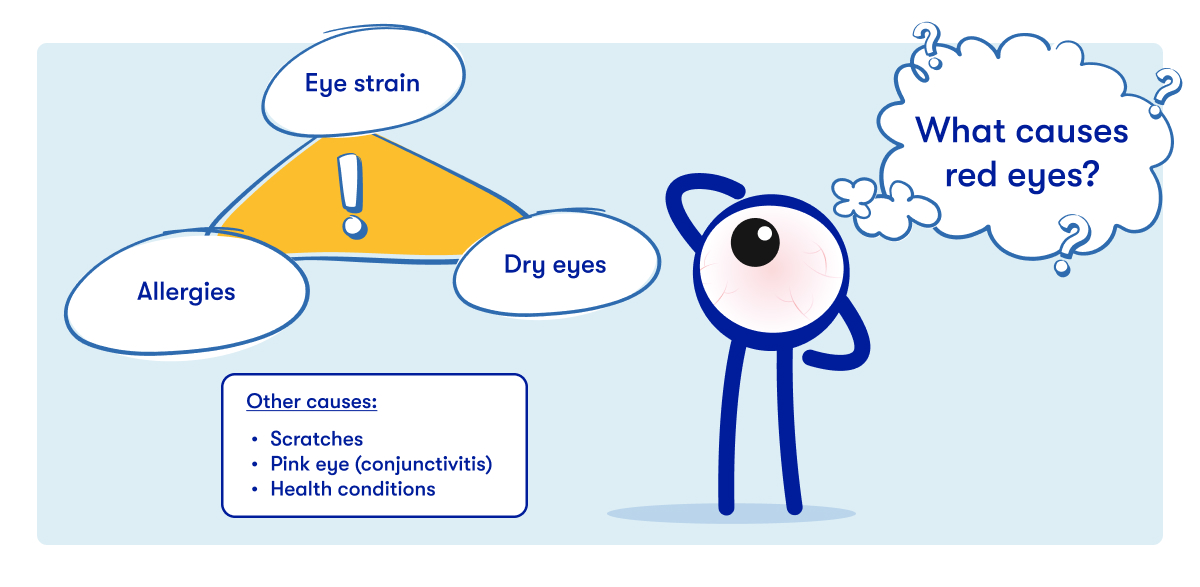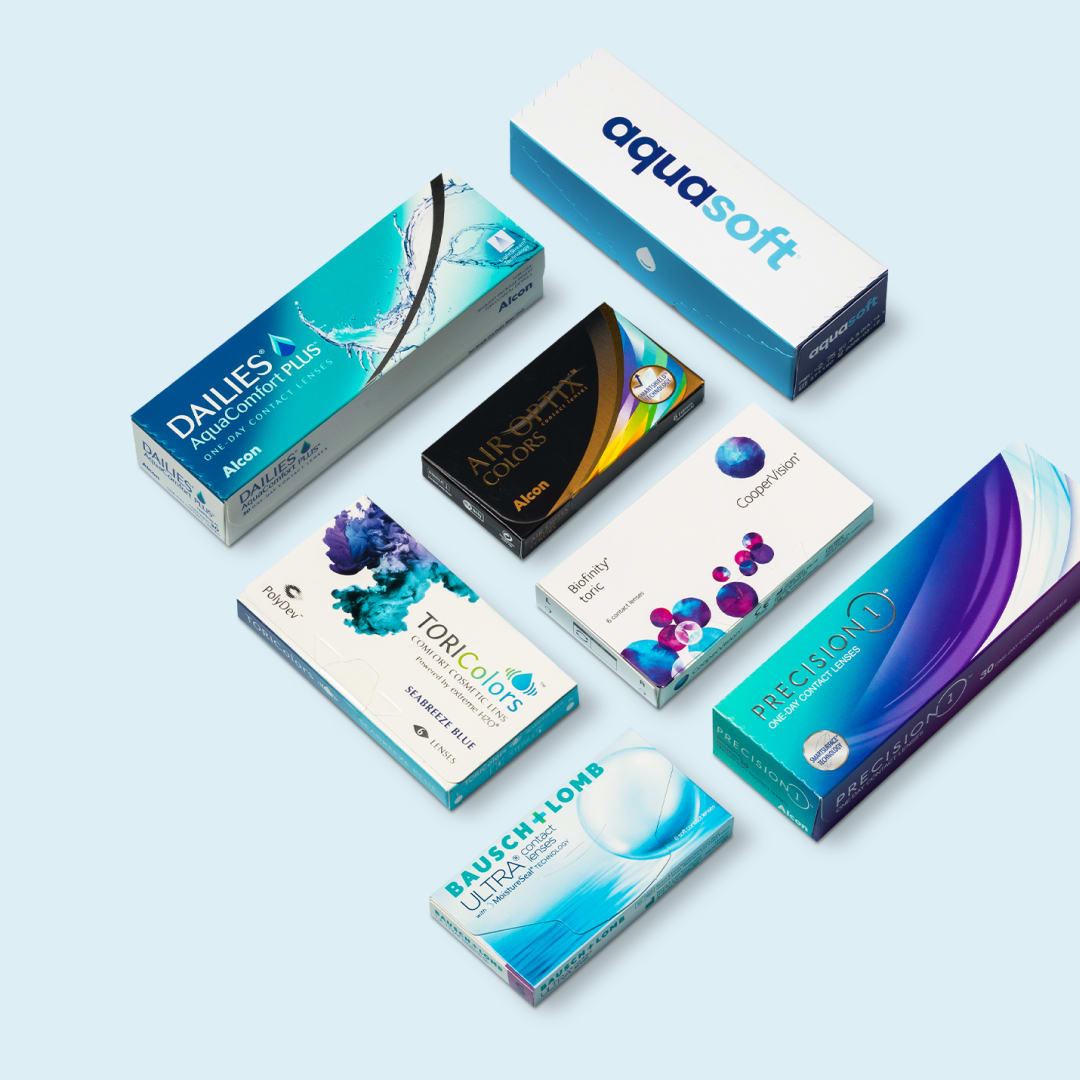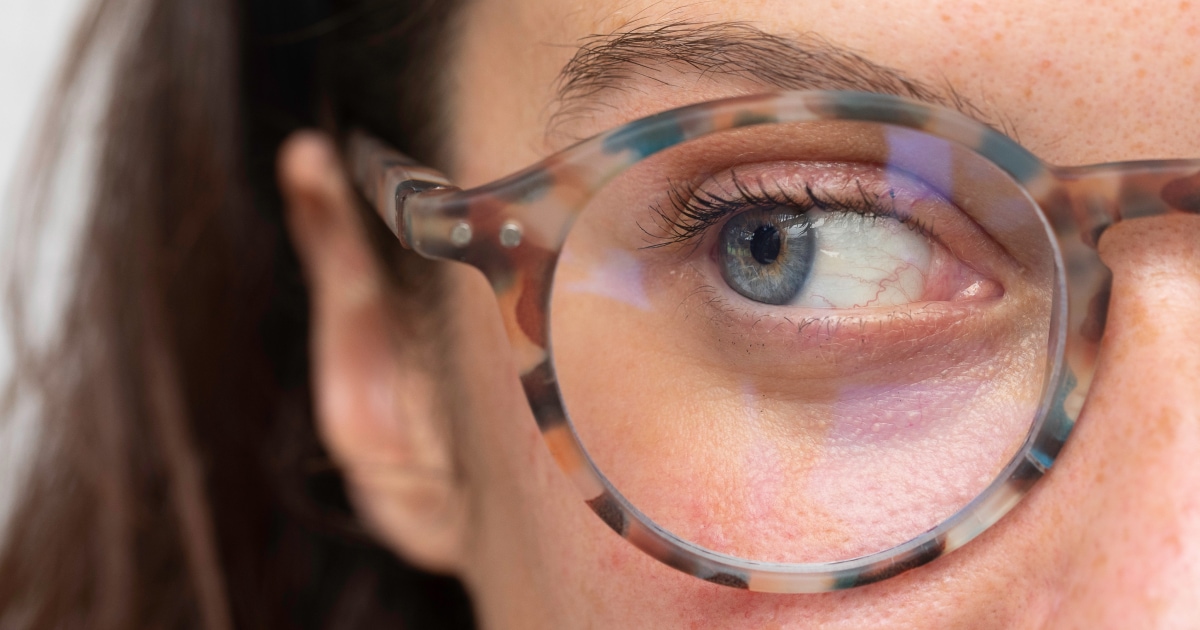Blood vessels visible in eyes
You wake up, glance in the mirror, and — hang on a second — why do your eyes look like they just pulled an all-nighter without you? Those tiny red lines weaving across the whites of your eyes? They’re innocent blood vessels. But when they become more visible than usual, your eyes might be sending you a warning.
Most of the time, something simple makes blood vessels visible in eyes, such as dry air, eye strain, a bit too much screen time, or a solid crying session (we’ve all been there). But if your eyes are chronically red, it could be a bigger issue, such as inflammation, infection, diabetes, or even high blood pressure.
Let’s spotlight the biggest culprits:
-
Prolonged exposure to sunlight
-
Pollution
-
Contact lenses
-
Drugs or alcohol
-
Allergies
-
Dehydration or dry eyes
-
Chemical irritants
-
Crying or stress
-
Lack of sleep
-
Eye strain
-
Cold or flu
-
Injury to the eye
-
Corneal abrasions or ulcers
-
Blepharitis (eyelid inflammation)
-
Diabetes
-
High blood pressure
-
Uveitis (middle eye inflammation)
-
Glaucoma
Now that we’ve covered every reason your eye blood vessels might be staging a rebellion, we’ll look at what causes red eyes, how to prevent visible blood vessels, how to treat it, and when to see an eye care professional.

Eye anatomy 101: What’s actually happening when your eyes turn red?
Your eyes might seem like mystical orbs of wonder, but they’re more like tiny, hardworking machines. Like any machine, they need a reliable fuel system — blood vessels. These microscopic highways deliver oxygen and other nutrients behind the scenes, helping you deliver the shadiest side-eye.
But why are the veins in my eye so visible? And where do these tiny but mighty vessels live? They’ve got real estate in:
-
The conjunctiva: This thin, transparent layer covers the whites of your eyes (sclera). It’s packed with tiny blood vessels that stay invisible — until allergies, dryness, or too much rubbing make them stand out like overworked neon signs.
-
The sclera: The tough, white outer shell of your eye is called the sclera. It holds deeper blood vessels, which usually stay hidden.
-
The cornea: This crystal-clear dome at the front of your eye has zero blood vessels (because vision is best without roadblocks). But if it’s injured, infected, or starved of oxygen, nearby vessels may creep in to compensate — often leaving your eyes looking redder than a sunburnt tourist.
The blood vessels in your eyes are always there, doing their job behind the scenes — but if they’re suddenly crying out for your attention in the mirror, there’s probably a good reason.

Order Contact Lenses Online
Learn how to order contact lenses online at 1-800 Contacts
Order contacts
Is it normal to see blood vessels in the eye?
Yes, it can be normal to see blood vessels in your eyes, but it depends on how noticeable they are.
Without normal blood vessels, your cornea and surrounding tissues wouldn’t get the oxygen and nutrients they need to function. But noticing them more than usual? That’s a different story.
Let's take a look at the difference between blood vessels, veins, and capillaries:
-
Blood vessels are the circulatory system in your eyes, including arteries, veins, capillaries, and smaller microvessels.
-
Veins carry oxygen-depleted blood away — kind of like your eyes’ garbage collectors, clearing out waste so your vision stays sharp.
-
Capillaries are the tiniest of the bunch, and they’re most likely to flare up when your eyes are inflamed, overworked, dry, or reacting to allergens.
If your blood vessels are suddenly stealing the show, the issue isn’t the veins themselves — it’s what’s making them stand out. Maybe you forgot to blink while doomscrolling, ignored your screen time limits, skipped your allergy meds, or your contact lenses are long overdue for renewal.
Whatever the reason for visible veins in eyes, if those pesky vessels stick around, keep getting worse, or make your eyes feel sore and gritty, your eyes aren’t being drama queens, they’re sending a warning.
Temporary causes
Most of the time, red blood vessels in eyes are just here for a quick visit, like an overly enthusiastic neighbor who pops by but (thankfully) doesn’t stay long. These triggers flare up and leave once your eyes recover. If your eyes look red but feel normal again after a few hours or a solid night’s sleep, you’re likely dealing with one of these:
-
Prolonged exposure to sunlight: You spent the day outside living your best life, but now your eyes feel dry and burn when you blink.
-
Pollution: You innocently open a window or take a deep breath outside, and within seconds, your eyes start watering, your nose joins in, and suddenly, your eyes have a full-on meltdown.
-
Contact lenses: You finally remove your lenses after a long day, expecting sweet relief, but instead, your eyes are scratchy, your vision’s a little off, and it feels like they’re punishing you for making them work overtime.
-
Drugs or alcohol: You wake up, glance in the mirror, and your eyes look like they went to the afterparty without you — dry, red, and making it clear you didn't drink enough water last night.
-
Allergies: Your immune system thinks pollen, pet dander, and dust are a national security threat and launches an attack — cue itchy, swollen, red eyes and excessive tearing.
-
Dehydration or dry eyes: After a long day in air conditioning, on airplanes, or just forgetting water exists, your eyes feel like crumpled paper and look just as rough.
-
Chemical irritants: You take a shower, and somehow, your shampoo launches an assault directly into your eyeballs — now they’re red, burning, and making you rethink your entire hygiene routine.
-
Crying or stress: You let your emotions run wild (whether it’s over real life or a surprisingly touching commercial), and now your eyes are red, puffy, and practically screaming, “Yes, I’ve been crying, so what?”
-
Lack of sleep: You stayed up for no good reason (again), and now your eyes are dry, irritated, and fully judging you.
-
Eyestrain: You’ve been staring at a screen for hours, and now you have blurry vision, your eyes feel heavy, and they look like they’ve just pulled an all-nighter in a Vegas casino.
-
Cold or flu: Your throat hurts, your nose is a lost cause, and your eyes have decided to join the misery parade with redness, puffiness, and general exhaustion.
-
Injury to the eye: You rubbed your eye a little too aggressively, got hit with an unexpected eyelash, or poked yourself with a mascara wand, and now your eye is red, watering, and making sure you know you messed up.
Chronic causes
Unlike temporary red eyes, these causes of red eyes don’t just disappear with a nap or a glass of water. If your eye redness is constant or getting worse, it’s time to see an eye professional in case you’re dealing with one of these guys:
-
Corneal abrasions or ulcers: You wake up and one eye is sore, weirdly light-sensitive, and seems to have a personal vendetta against your contact lenses. No amount of blinking fixes it.
-
Blepharitis (eyelid inflammation): Every morning, your eyelids feel crusty, your eyes are red, and washing your face only makes them angrier.
-
Conjunctivitis (pink eye): You wake up and — fantastic. One eye is swollen, redder than a stop sign, and sealed shut with gunk.
-
Diabetes: When blood vessels are visible in your eyes and you experience heightened thirst, more frequent bathroom breaks, unexplained weight loss, and blurred vision, your blood sugar levels could be off balance,
-
High blood pressure: Your doctor checks your BP and says, “Let’s talk about your salt intake and those bloodshot eyes.”
-
Uveitis (middle eye inflammation): Out of nowhere, one eye turns red, starts aching, and suddenly hates bright lights. It’s acting like it has a migraine… but it’s just your eye.
-
Glaucoma: You’ve noticed your peripheral vision isn’t as sharp as it used to be, and your eyes look red more often than not.
Subconjunctival hemorrhage is a red spot that looks scarier than it is
If you wake up with a bright red patch in your eye that wasn’t there the night before, don’t panic. It’s likely a subconjunctival hemorrhage, AKA a burst blood vessel under the conjunctiva.
What causes this?
-
Straining (sneezing, coughing, pooping (ew), lifting heavy objects).
-
Rubbing your eyes too hard.
-
Minor trauma (like poking yourself in the eye with your own hand).
-
High blood pressure or blood-thinning medications.
It can look intense, but it’s usually harmless and clears up within one to two weeks.
How to prevent visible blood vessels
Red eyes are not the most on-point fashion choice, and, luckily, they’re highly preventable. A few smart habits can keep those blood vessels from stealing the spotlight:
-
Give your eyes a break: Follow the 20-20-20 rule — every 20 minutes, look 20 feet away for 20 seconds. Consider it a mental reset for your brain and your eyeballs. And don’t forget to blink — screens trick you into staring like a statue, and your eyes aren’t supposed to feel like sandpaper. If they do, grab some artificial tears.
-
Protect your eyes from the world: If you find yourself squinting in the outdoors like you’re in an old-timey Western, it’s time to invest in sunglasses. UV rays aren’t doing you any favors. And if smoke, dust, or chemical fumes make your lungs unhappy, guess what? Your eyes aren’t fans, either.
-
Make smart lifestyle choices: Hydrate — coffee doesn’t count, water does. Actually get some sleep instead of pretending you don’t need it. If your contacts feel welded to your eyeballs, switch to glasses for a day. And if you’re waking up with red eyes after partying a little too hard, cutting back on drugs or alcohol might be worth considering. Smoking? Same deal.
Your eyes work hard to make sure you see every detail of the sunset — return the favor. A few small changes can keep them clear and decidedly less red.
Treatment for visible eye blood vessels
Most of the prevention tips above double as treatments — because sometimes, your eyes just need a little extra care to bounce back. Taking breaks from screens, staying hydrated, getting enough sleep, and protecting your eyes from irritants can help redness fade faster.
But if your red eyes are caused by an underlying condition, treating the root issue is the only option. Here’s how different conditions might be handled:
-
For dry eyes: Artificial tears, warm compresses, and limiting screen time can help restore moisture.
-
For allergies: Antihistamine eye drops or oral allergy meds can help reduce inflammation and redness.
-
For infections (like conjunctivitis): Depending on whether it’s bacterial or viral, you may need antibiotics or antiviral eye drops.
-
For high blood pressure: Managing your overall health through diet, exercise, and medication can help reduce blood vessel dilation.
-
For glaucoma: Prescription eye drops or surgical intervention may be required to manage pressure in the eye.
-
For uveitis: Anti-inflammatory or steroid eye drops are often necessary to control inflammation.

When to see an eye care professional
Book an appointment with an eye pro if:
-
You have a persistent headache, confusion, or blurry vision — especially if it’s out of nowhere.
-
You’ve injured your eye, even if it seems minor. A tiny scratch can turn into a big problem fast.
-
Your eyes are leaking discharge or pus (sorry, but if it’s oozing, it’s urgent).
-
You’re extremely sensitive to light and need sunglasses indoors like a rockstar — but not in a good way.
-
You see halos around lights or your vision feels “off” in a way that’s hard to explain.
-
You feel nauseous or are vomiting — especially if it comes with eye pain or pressure.
- You’re on blood-thinning medication and your eyes are bleeding or showing unusual redness.
Don’t ignore chronic redness!
In most cases, when blood vessels in eyes are more visible, it's harmless, but chronic redness can indicate a deeper issue. Pay attention to symptoms and don’t hesitate to see an eye care professional if red eye persists or feels sore.
Need an eye exam? Check out 1-800 Contacts for a convenient online eye exam, easy ordering, and expert support. Your eyes will thank you!
Did you know you can order contacts online?
Say goodbye to trips to the eye doctor and hello to convenience! With 1-800 Contacts, you can easily order your contact lenses online and have them delivered straight to your door. Plus, our online vision exam makes it simple to get the prescription you need without leaving home. And the best part? You’ll save money on your first order with 1-800 Contacts. It’s never been easier to get your contacts!
Original publish date: 8/7/2023
Updated: 3/28/25





